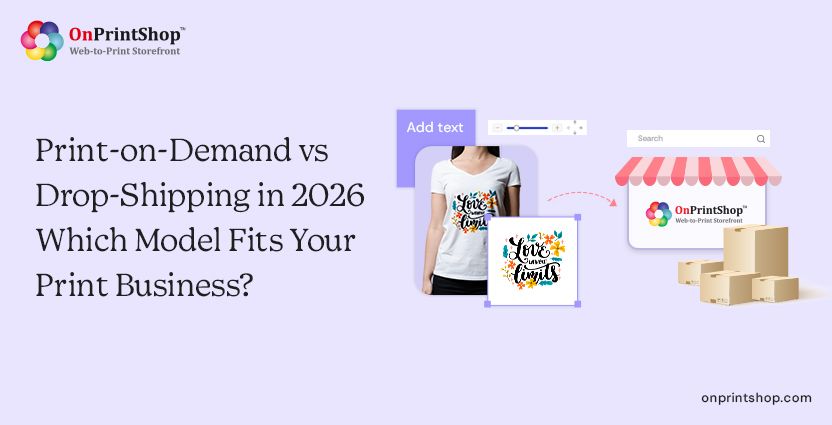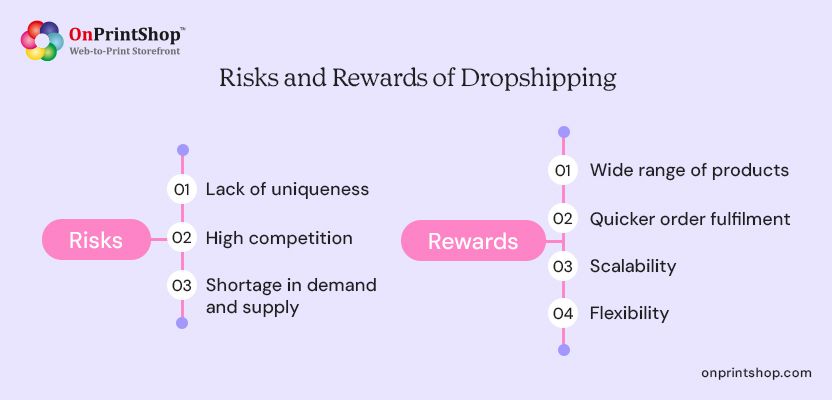OnPrintShop v12.3 is here: Smarter Personalization, Smoother Workflows & Admin Controls - Learn More
Back to Blog Page
Print-on-demand vs Dropshipping: Which One to Choose in 2026?

Quick Summary: Zero inventory is not a nightmare; it’s just the new way to deal with closing stock. Start an order fulfillment business and forget about managing inventory. But which business model should you go with? Print-on-demand or Dropshipping? To answer that, you need to know the risks and rewards of print-on-demand vs dropshipping. So, keep reading on.
Congratulations on deciding to get into the order fulfillment business. It could not be a better time than this.
The global market marked USD 109,556.4 million as the revenue for the order fulfillment industry in 2023. And experts project this figure to hike up to 272,141.6 million by 2030.
Additionally, the next-gen web-to-print solutions have opened an opportunity for businesses like print-on-demand and drop-shipping to close the supply and demand gap.
But do you know exactly which business model do you want to adopt?
Print-on-demand or dropshipping?
If you are having a never-ending ‘Print-on-demand vs Dropshipping’ tennis match in your head, relax because you are in the right place.
This blog will finish that match with an ace.
We will discuss each model in detail, know the advantages and disadvantages of both, and compare the two models to make a well-informed decision.
So, without any further ado, let’s start by defining both the business models.
On This Page
What Is Dropshipping?
Dropshipping is an e-commerce model where the seller doesn't maintain the product inventory but acts as a middleman between customers and a third-party supplier.
When a drop shipping company gets a purchase order, they contact the supplier and get the order shipped to the customer. A dropshipping business can sell a variety of products. These products are usually the things that are trending hot in the market at the moment.
How Does the Dropshipping Work?
We would again use an example putting you as the drop-shipping business owner to give you a perspective.
Isn’t it quite effective?
So, you have an online store where you sell mobile accessories and small electronics such as earphones, headphones, Bluetooth speakers, charging adapters, cables, and cool phone covers.
Unlike traditional stores, you do not buy them at wholesale price, hoard them, and then sell them. You reroute the order from your customer directly to the supplier to fulfil the order.
Instead of managing production of inventory, you can focus on getting new orders as soon as you transfer the order to the supplier. This results in lowering down of your operating costs drastically.
What Is Print-on-demand?
Print-on-demand (POD) is when the print sellers get the products printed after accepting the purchase order by the print buyers. That is why it is an order fulfilment business model for selling personalized printed products like apparels, mugs, journals, etc. So, basically a print-on-demand is a dropshipping business but for customized print products.
Now, a POD business owners have the option of either printing the products themselves or getting it from a supplier like trade printer, or a third-party printer. But like an order fulfilment business, they don't manage inventory in either of the cases. They print it or get it printed only once the order has been placed by the purchaser.
Is it confusing for you? Let’s understand the print-on-demand business in detail by knowing how it works.
How Does the Print-on-demand Work?
We will try to understand this by an example. Suppose you already own a successful print-on-demand business. You have an online designer studio where customers can customize products such as apparels, canvases, mugs, stationery, bags, phone accessories, badges, toiletries, tapestries, and whatnot.
Now, once a customer places an order with their customization requirements, you transfer that order to print-on-demand suppliers, which are printers, via a print shop automation software, or print it yourself.
In the former case, the print on order business controls the order placement and packaging style but it does not manage the production or shipment of the actual product. Whereas in the latter case, the POD service provider is responsible for printing, packaging, and shipping the order and therefore they also have more control on the profit margin.
Which means, yes you guessed it right.
No inventory cost.
No need of invest on equipment.
Now you know why print-on-demand companies have a relatively high profit margin.
Are you ready to make millions out of the order fulfilment business?
Wait, before betting everything of it. Let's learn about the risks and rewards of these business models and know your risks.
Risks and Rewards: Dropshipping

Risks:
- Lack of uniqueness
With drop-shipping model, you don’t get to design the products as per your creativity and neither can your customers. So, you can sell a unique product only if you convince a supplier to not to sell their product elsewhere.
- High competition
As a dropshipping business, you have to compete with numerous other businesses trying to sell the same products.
- Shortage in demand and supply
As you do not control the production of the products, you might face lack of stocks on the suppliers' end.
Rewards:
- Wide range of products
As a dropshipping business, you do not have to commit to a single line of products. You can sell a variety of products from different vendors. Moreover, you can even change the niche of products as per the present trends.
- Quicker order fulfilment
Though you do not manage an inventory, your suppliers do. This way, the products are all set with the suppliers for dropshipping.
- Scalability
One of the biggest advantages of dropshipping business is that you can always add new line of products to your store and grow your business.
- Flexibility
The dropshipping business provides you with the flexibility to sell your products on established platforms like Amazon, eBay, and Shopify.
Aren’t you in a better position to decide after knowing the pros and cons of both the businesses in terms of rewards and risks? Now, to pick the one for you, let’s compare print-on-demand & dropshipping side by side.
Risks and Rewards: Print-on-demand

Risks:
- Limited SKUs
Though you have creative and unique product line, you will have a limitation on range of products you can sell.
- Dependency on suppliers
As you do not print the products yourselves, you have to rely on third party printers for quality of the products and the time taken to ship them.
- High shipping charges
Sometimes, it is not possible to find a printer that is near to the shipping address. And those are the times, you have to pay a higher shipping cost.
Rewards:
- Nominal start-up cost
Print-on-demand is one of the businesses with the lowest capital investment. All you need is a advanced web-to-print storefront.
- Your own brand
With your own web-to-print storefront, you can sell niche specific products and create your own brand.
- High selling price
As you get to sell nice-specific, limited products, the loyal customers are willing to pay way more than what it costs you.
- Creative customization
With a print-on-demand business, you are in-charge of the creativity. You can let your customers customize products the way they want or offer your creatives as a product. This boosts customer satisfaction and eventually results in high revenue.
Print-on-demand vs Drop Shipping: Striking Similarities
Despite of differences, there are many similarities between POD and dropshipping. And that’s where it gets more confusing.
Right?
So, to sort this confusion, here are some similarities to understand both the business models better.
- No need of a physical store
You do not need a physical store or a production line to sell products, you can sell your products with an online platform.
- No need of managing inventory
It’s not just about the physical store, you don’t even need to manage an inventory because you are redirecting the order to a third-party manufacturer.
- Order on demand
Whether it is anyone of dropshipping or POD, you place order to the supplier when you get an order and not the other way around.
- Reliability on suppliers
In both the cases you have to rely entirely on the suppliers for meeting the production, packaging, and shipment.
Now that we have understood the similarities, let’s discuss the difference between dropshipping and print-on-demand.

Dropshipping vs Print-on-demand: Major Differences
What’s the best way to distinguish between any two concepts?
That’s right, by listing their differences.
So, let’s list differences of dropshipping vs POD.
- Customizability
POD allows your customers to buy personalized products, whereas the drop-shipping restricts creativity in customizing the products.
- Number of products
You can sell several products with drop-shipping platform, but when it comes to POD platform, you have to limit yourself to a certain number of products that go with your niche.
- Production
As POD products are highly customized, printers print them after getting the order from the POD business. On the other hand, best dropshipping suppliers do not wait for the order from the drop-shipping companies as they have to maintain their inventory and the products are not customized.
That’s all you need to know about POD and dropshipping businesses. This is the time for you to pick one and get started.
Wait, are you still on the fence?
Let’s jump to the verdict and help you choose one that would be the most profitable for you in the year 2024.
Which One to Pick: Print-on-demand vs DropshippingWhen it comes to POD VS dropshipping for your business, it all boils down to your business plan. What exactly are the products that you want to sell.If you are here to make quick money on the fastest selling products online, drop-shipping is the right model for you. Create an online platform and list down the products that you want to sell. Build a supply and demand channel, and you have a business.If you have a creative capital and can design unique products, POD is the best business for you. Create a standout brand for that connects with your audience. This way you can satisfy your creative soul and grow your business too.Whether you choose print-on-demand or dropshipping, the biggest challenge in getting your business up and running is having an online storefront. Well, no need to worry about that anymore. OnPrintShop, the leading web-to-print solutions providers, is here to help you create your first online storefront where you can sell your products, manage orders, mange client and suppliers’ communications, and everything related to run your business.So, what are you waiting for? Book a live demo with our experts and bring your print business plan into action.
FAQ's
POD vs Dropshipping, what is the basic difference between the two? 
Which business model requires a higher initial investment?
Which has higher profit margins: Print-on-demand or Dropshipping?
Can I run both Print-on-demand and Dropshipping businesses simultaneously? 
#1 Web to Print Software.
By submitting this form, you agree to our Privacy Policy





